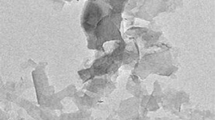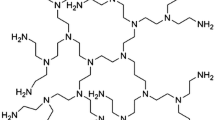Abstract
DPPH (2,2-diphenyl-1-picrylhydrazil), a free radical-containing organic compound, is used widely to evaluate the antioxidant properties of plant constituents. Here, we report an efficient electroactive DPPH molecular system with excellent electrocatalytic sensor properties, which is clearly distinct from the traditional free radical-based quenching mechanism. This unusual molecular status was achieved by the electrochemical immobilization of graphene oxide (GO)-stabilized DPPH on a glassy carbon electrode (GCE). Potential cycling of the DPPH adsorbed-GCE/GO between − 1 and 1 V (Ag/AgCl) in a pH 7 solution revealed a stable and well-defined pair of redox peaks with a standard electrode potential, E0′ = 0 ± 0.01 V (Ag/AgCl). Several electrochemical characterization studies as well as surface analysis of the GCE/GO@DPPH-modified electrode by transmission electron microscopy, Raman, and infrared spectroscopy collectively identified the imine/amine groups as the redox centers of the electroactive DPPH on GO. The use of different carbon-supports showed that only oxygen-functionalized GO and MWCNTs could provide major electroactivity for DPPH. This highlights the importance of a strong hydrogen-bonded network structure assisted by the concomitant π-π interactions between the organic moiety and oxygen function groups of carbon for the high electroactivity and stability of the GCE/GO@DPPH-NH/NH2-modified electrode. The developed electrode exhibited remarkable performance towards the electrocatalytic oxidation of NADH at 0 V (Ag/AgCl). The amperometric i-t sensing of NADH showed high sensitivity (488 nA μM−1 cm−2) and an extended linear range (50 to 450 μM) with complete freedom from several common biochemical/chemical interferents, such as ascorbic acid, hydrazine, glucose, cysteine, citric acid, nitrate, and uric acid.











Similar content being viewed by others

References
Xie J, Schaich KM (2014) Re-evaluation of the 2, 2-diphenyl-1-picrylhydrazyl free radical (DPPH) assay for antioxidant activity. J Agric Food Chem 62(19):4251–4260
Perez-Roses R, Risco E, Vila R, Penalver P, Cañigueral S (2016) Biological and nonbiological antioxidant activity of some essential oils. J Agric Food Chem 64(23):4716–4724
Zhang L, Ravipati AS, Koyyalamudi SR, Jeong SC, Reddy N, Smith PT, Bartlett J, Shanmugam K, Münch G, Wu MJ (2011) Antioxidant and anti-inflammatory activities of selected medicinal plants containing phenolic and flavonoid compounds. J Agric Food Chem 59(23):12361–12367
Singh N, Rajini PS (2004) Free radical scavenging activity of an aqueous extract of potato peel. Food Chem 85(4):611–616
Nuutila AM, Puupponen-Pimiä R, Aarni M, Oksman-Caldentey KM (2003) Comparison of antioxidant activities of onion and garlic extracts by inhibition of lipid peroxidation and radical scavenging activity. Food Chem 81(4):485–493
Zhang W, Zeng Z, Wei J (2017) Electrochemical study of DPPH radical scavenging for evaluating the antioxidant capacity of carbon nanodots. J Phys Chem C 121(34):18635–18642
Amatatongchai M, Laosing S, Chailapakul O, Nacapricha D (2012) Simple flow injection for screening of total antioxidant capacity by amperometric detection of DPPH radical on carbon nanotube modified-glassy carbon electrode. Talanta 97:267–272
Chua LS, Rahaman NL, Adnan NA, Eddie Tan TT (2013) Antioxidant activity of three honey samples in relation with their biochemical components. J Anal Methods Chem 2013:1–8. https://doi.org/10.1155/2013/313798
Wang T, Jonsdottir R, Ólafsdóttir G (2009) Total phenolic compounds, radical scavenging and metal chelation of extracts from Icelandic seaweeds. Food Chem 116(1):240–248
Balamurugan J, Thanh TD, Kim NH, Lee JH (2016) Facile fabrication of FeN nanoparticles/nitrogen-doped graphene core-shell hybrid and its use as a platform for NADH detection in human blood serum. Biosens Bioelectron 83:68–76
Gupta B, Kumar N, Panda K, Kanan V, Joshi S, Visoly-Fisher I (2017) Role of oxygen functional groups in reduced graphene oxide for lubrication. Sci Reports 7 doi: https://doi.org/10.1038/srep45030
Aparecida I, Ribeiro L, Yotsumoto-Neto S, Santos WTP, Fernandes RN, Goulart MOF, Damos FS, Luz RCS (2017) Improved NADH electroanalysis on nickel(II) phthalocyanine tetrasulfonic acid/calf thymus deoxyribo nucleic acid/reduced graphene oxide composite. J Braz Chem Soc 28:1768–1778
Eguílaz M, Gutierrez F, González-Domínguez JM, Martínez MT, Rivas G (2016) Single-walled carbon nanotubes covalently functionalized with polytyrosine: a new material for the development of NADH-based biosensors. Biosens Bioelectron 86:308–314
Wu L, Zhang X, Ju H (2007) Detection of NADH and ethanol based on catalytic activity of soluble carbon nanofiber with low overpotential. Anal Chem 79(2):453–458
Puchakayala S, Annamalai SK (2012) Electrocatalytic oxidation of NADH using alizarin immobilized carbon nanotube modified electrode. ECS Trans 41(27):9–14
Tığ GA (2017) Highly sensitive amperometric biosensor for determination of NADH and ethanol based on Au-Ag nanoparticles/poly(L-cysteine)/reduced graphene oxide nanocomposite. Talanta 175:382–389
Bihar E, Deng Y, Miyake T, Saadaoui M, Malliaras GG, Rolandi M (2016) A disposable paper breathalyzer with an alcohol sensing organic electrochemical transistor. Sci Reports 6, 1. DOI: https://doi.org/10.1038/srep275826
Kim DM, Kim MY, Reddy SS, Cho J, Cho CH, Jung S, Shim YB (2013) Electron-transfer mediator for a NAD-glucose dehydrogenase-based glucose sensor. Anal Chem 85(23):11643–11649
Achmann S, Hermann M, Hilbrig F, Jérôme V, Hämmerle M, Freitag R, Moos R (2008) Direct detection of formaldehyde in air by a novel NAD+-and glutathione-independent formaldehyde dehydrogenase-based biosensor. Talanta 75(3):786–791
Quan D, Shin W (2010) A nitrite biosensor based on co-immobilization of nitrite reductase and viologen-modified chitosan on a glassy carbon electrode. Sensors 10(6):6241–6256
Liu Y-C, Su Y-M, Chen K-J, Huang W-C, Kuob Y-L, Lin SD (2017) Electrocatalysis of a enhancement of a screen-printed carbon electrode by modification with Trisoctahedral gold nanocrystals for H2O2 and NADH sensing application. J Chem Technol Biotechnol 92(9):2460–2467
Aneesh K, Berchmans S (2017) Enhanced peroxidase-like activity of CuWO4 nanoparticles for the detection of NADH and hydrogen peroxide. Sensors Actuators B Chem 253:723–730
Canevari TC, Cincotto FH, Gomes D, Landers R, Toma HE (2017) Magnetite nanoparticles bonded carbon quantum dots magnetically confined onto screen printed carbon electrodes and their performance as electrochemical sensor for NADH. Electroanalysis 29(8):1968–1975
Gligor D, Dilgin Y, PopescuI C, Gorton L (2005) Poly-phenothiazine derivative-modified glassy carbon electrode for NADH electrocatalytic oxidation. Electrochim Acta 54:3124–3128
Lee L, Leroux YR, Hapiot P, Downard AJ (2015) Amine-terminated monolayers on carbon: preparation, characterization, and coupling reactions. Langmuir 31(18):5071–5077
Sharifi E, Salimi A, Shams E (2013) Electrocatalytic activity of nickel oxide nanoparticles as mediatorless system for NADH and ethanol sensing at physiological pH solution. Biosens Bioelectron 45:260–266
Roushani M, Hoseini SJ, Azadpour M, Heidari V, Bahrami M, Maddahfar M (2016) Electrocatalytic oxidation behavior of NADH at Pt/Fe3O4/reduced-graphene oxide nanohybrids modified glassy carbon electrode and its determination. Mater Sci Engg C 67:237–246
Chen CH, Chen YC, Lin MS (2013) Amperometric determination of NADH with Co3O4 nanosheet modified electrode. Biosens Bioelectron 42:379–384
Guo S, Wen D, Zhai Y, Dong S, Wang E (2010) Platinum nanoparticle ensemble-on-graphene hybrid nanosheet: one-pot, rapid synthesis, and used as new electrode material for electrochemical sensing. ACS Nano 4(7):3959–3968
Balamurugan A, Ho KC, Chen SM, Huang TY (2010) Electrochemical sensing of NADH based on Meldola Blue immobilized silver nanoparticle-conducting polymer electrode. Colloids Surf A: Physicochem Eng Asp 362(1):1–7
Manesh KM, Santhosh P, Gopalan A, Lee KP (2008) Electrocatalytic oxidation of NADH at gold nanoparticles loaded poly(3,4-ethylenedioxythiophene)–poly(styrene sulfonic acid) film modified electrode and integration of alcohol dehydrogenase for alcohol sensing. Talanta 75(5):1307–1314
Lu J, Liu Y, Liu X, Lu X, Liu X (2016) Construction of a highly sensitive NADH sensing platform based on PDDA-rGO nanocomposite modified electrode. Ionics 22(11):2225–2233
Topcu E, Dagci K, Alanyahoglu M (2016) Electrochemical immunoassays based on graphene: a review. Electroanalysis 28:1–13
Roushani M, Karami M, Dizajdizi BZ (2017) Amperometric NADH sensor based on a carbon ceramic electrode modified with the natural carotenoid crocin and multi-walled carbon nanotubes. Microchim Acta 184(2):473–481
Menanteau T, Levillain E, Breton T (2014) Spontaneous grafting of nitrophenyl groups on carbon: effect of radical scavenger on organic layer formation. Langmuir 30(26):7913–7918
Parsa A, Salout SA (2014) Investigation of the antioxidant activity of electro synthesized polyaniline/reduced graphene oxide nanocomposite in a binary electrolyte system on ABTS and DPPH free radicals. J Electroanal Chem 760:113–118
Madhu R, Karuppiah C, Chen SM, Veerakumar P, Liu SB (2014) Electrochemical detection of 4-nitrophenol based on biomass derived activated carbons. Anal Methods 6(14):5274–5280
Thirumalraj B, Selvakumar P, Chen SM (2015) An amperometric nitrobenzene electrochemical sensor based on electrochemically activated graphite modified screen printed carbon electrode. Int J Electrochem Sci 10:4173–4182
Senthil Kumar SM, Chandrasekara Pillai K (2006) Cetyltrimethyl ammonium bromide surfactant-assisted morphological and electrochemical changes in electrochemically prepared nanoclustered iron(III) hexacyanoferrate. J Electroanal Chem 589(1):167–175
Kumar AS, Shanmugam R, Vishnu N, Chandrasekara Pillai K, Kamaraj S (2016) Electrochemical immoblisation of ellagic acid phytochemical on MWCNT modified carbon electrode surface and its efficient hydrazine electrocatalytic activity in neutral pH. J Electroanal Chem 782:215–224
Zhang J, Yang H, Shen G, Cheng P, Zhang J, Guo S (2010) Reduction of graphene oxide via L-ascorbic acid. Chem Commun 46(7):1112–1114
Stankovich S, Dikin DA, Piner RD, Kohlhaas KA, Kleinhammes A, Jia Y, Wu Y, Nguyen ST, Ruoff RS (2007) Synthesis of graphene-based nanosheets via chemical reduction of exfoliated graphite oxide. Carbon 45(7):1558–1565
Acik M, Lee G, Mattevi C, Pirkle A, Wallace RM, Chhowalla M, Cho K, Chabal Y (2011) The role of oxygen during thermal reduction of graphene oxide studied by infrared absorption spectroscopy. J Phys Chem C 115(40):19761–19781
Ali MA, Singh C, Srivastava S, Admane P, Agrawal VV, Sumana G, John R, Panda A, Dong L, Malhotra BD (2017) Graphene oxide–metal nanocomposites for cancer biomarker detection. RSC Adv 7(57):35982–35992
Gayathri P, Kumar AS (2013) An Iron impurity in multiwalled carbon nanotube complexes with chitosan that biomimics the heme-peroxidase function. Chem Euro J 19(50):17103–17112
Bard AJ, Faulkner LR (1980) Electrochemical methods. Fundamentals and Applications Wiley, New York
Kumar AS, Gayathri P, Barathi P, Vijayaraghavan R (2012) Improved electric wiring of hemoglobin with impure-multiwalled carbon nanotube/nafion modified glassy carbon electrode and its highly selective hydrogen peroxide biosensing. J Phy Chem C 116(44):23692–23703
Burke LD, Murphy OJ (1980) The electrochemical behaviour of RuO2-based mixed-oxide anodes in base. J Electroanal Chem 109(1-3):199–212
Senthil Kumar A, Chandrasekara Pillai K (2000) Studies of electrochemical of RuO2-PVC film electrodes: dependence on oxide preparation temperature. J Solid State Electrochem 4(7):408–416
Dharuman V, Chandrasekara Pillai K (2006) RuO2 electrode surface effects in electrocatalytic oxidation of glucose. J Solid State Electrochem 10(12):967–979
Zhu L, Zhai J, Yang R, Tian C, Guo L (2007) Electrocatalytic oxidation of NADH with Meldola’s blue functionalized carbon nanotubes electrodes. Biosens Bioelectron 22(11):2768–2773
Maroneze CM, Arenas LT, Luz RCS, Benvenutti EV, Landers R, Gushikem Y (2008) Meldola blue immobilized on a new SiO2/TiO2/graphite composite for electrocatalytic oxidation of NADH. Electrochim Acta 53(12):4167–4175
Tang L, Zeng G, Shen G, Zhang Y, Li Y, Fan C, Liu C, Niu C (2009) Highly sensitive sensor for detection of NADH based on catalytic growth of Au nanoparticles on glassy carbon electrode. Anal Bioanal Chem 393(6-7):1677–1684
Chakraborty S, Retna Raj C (2007) Mediated electrocatalytic oxidation of bioanalytes and biosensing of glutamate using functionalized multiwall carbon nanotubes biopolymer nanocomposite. J Electroanal Chem 609(2):155–162
Huang T-Y, Huang J-H, Wei H-Y, Ho K-C, Chu C-W (2013) rGO/SWCNT composites as novel electrode materials for electrochemical biosensing. Biosens Bioelectron 43:173–179
Dai H, Xu H, Lin Y, Wu X, Chen G (2009) A highly performing electrochemical sensor for NADH based on graphite/poly(methylmethacrylate) composite electrode. Electrochem Commun 11(2):343–346
Otte N, Borelli C, Korting HC (2005) Nicotinamide—biologic actions of an emerging cosmetic ingredient. Int J Cosmet Sci 27(5):255–261
Acknowledgements
K.C.P. thanks the Korea Federation of Science and Technology Societies (KOFST, Republic of Korea) for offering him the position of Invited Scientist through the “Brain Pool Program.”
Funding
This study was supported by the National Research Foundation of Korea (NRF) funded by the Korea government (MEST) (Grant No. 2017R1A2A1A05001484) and the Department of Science and Technology (DST), Science and Engineering Research Board, Government of India.
Author information
Authors and Affiliations
Corresponding authors
Electronic supplementary material
ESM 1
(DOCX 122 kb)
Rights and permissions
About this article
Cite this article
Pillai, K.C., Shalini Devi, K.S., Senthil Kumar, A. et al. Selective and low potential electrocatalytic oxidation of NADH using a 2,2-diphenyl-1-picrylhydrazyl immobilized graphene oxide-modified glassy carbon electrode. J Solid State Electrochem 22, 3393–3408 (2018). https://doi.org/10.1007/s10008-018-4029-5
Received:
Revised:
Accepted:
Published:
Issue Date:
DOI: https://doi.org/10.1007/s10008-018-4029-5



